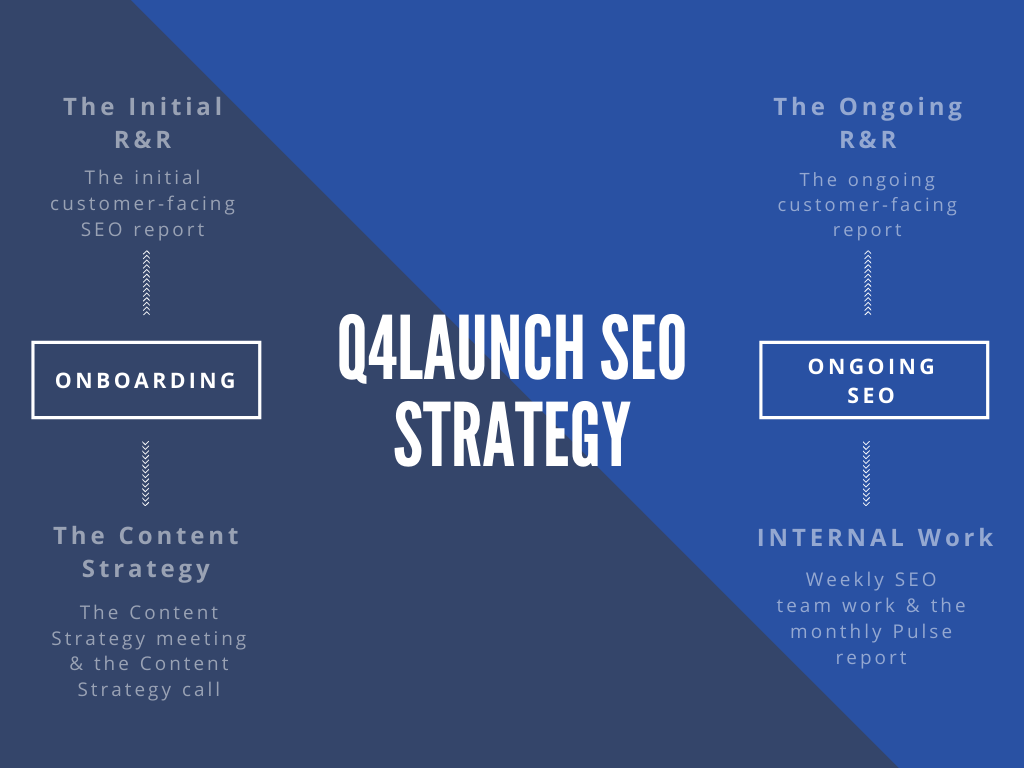The goal of the Q4 SEO strategy is to help our clients’ websites achieve the highest possible organic rankings and provide the best user experience to ultimately drive bookings.
The Q4 SEO strategy involves two main processes:
- Onboarding (the same for all new clients, regardless of package level)
- Ongoing Work (differs based on the client’s package level)
The details of each process are described below.
SEO Strategy Part 1. Onboarding
The goal of the SEO onboarding process is to give clients an understanding of their current SEO situation and introduce them to our SEO process at Q4Launch.
The SEO onboarding process includes two main pieces:
- The Initial SEO Report & Recommendations (Initial R&R)
- The Content Strategy
The Initial R&R
The Initial R&R is an external report sent to a new client during onboarding that contains an overview of the client’s current SEO status as well as recommendations for improvement.
Why do we send the Initial R&R to new clients?
There a few reasons for creating and delivering the Initial R&R:
- Creating the report sets a baseline for the client’s SEO performance. We’re able to see where they started and then how they progress over time.
- Sharing the Initial R&R gives the client an understanding of how their website is currently performing in terms of SEO and how we’re going to improve upon that.
- Sharing the report also helps to continue the line of communication with a new client who otherwise wouldn’t know all of the behind-the-scenes work that takes place during onboarding.
Who sends the report to the client and how is it shared?
The Initial R&R is delivered to the client by the CSM. The CSM is responsible for setting up a call with the client to review the report. For more details regarding the Initial R&R, see How to Conduct the Initial R&R Call.
Here’s a timeline of the Initial R&R process:

The Content Strategy
The Content Strategy is the second main part of the SEO onboarding process. It includes two steps:
- The Content Strategy Meeting
- The Content Strategy Call
The Content Strategy Meeting
The Content Strategy meeting is a time for the SEO, CC, & CSM to get together to develop an effective content strategy for a client. The purpose of this meeting is to create a cohesive content strategy that links the initial keyword research process with content creation.
How should I prepare for this meeting?
The SEO team will come to this meeting with a completed list of keyword topics as well as on-page edit recommendations for the top static pages on the client’s site. The content creator should come prepared with notes from the branding call, and the CSM should come prepared with notes regarding customer preferences from the kickoff call.
What’s covered in the meeting?
The meeting is meant to be open-ended and “brainstorm style,” but a few things definitely covered include:
- On-page edits
- Any static pages that should be included in the first marketing calendar
- Any questions regarding the layout of the new website
Following this meeting, the CSM should finalize the first marketing strategy calendar prior to the Content Strategy call.
The Content Strategy Call
The Content Strategy call takes place a few days after the Content Strategy meeting. Deliverables include on-page edits for static pages (prepared by the SEO team) and the first marketing strategy calendar (prepared by the CSM). The on-page edits and first marketing calendar aren’t physically in one document, but they are delivered to the client at the same time.
Why do we have the Content Strategy call?
- To explain to a new client the connection between SEO & content
- To provide a clear timeline of what we’ll be doing in terms of content
- To build trust by helping clients understand our keyword selection process, which should, in turn, save time for future marketing calendars
For more details on this call, see How to Conduct the Content Strategy Call.
Below is a timeline of the Content Strategy process. This timeline begins where the Initial R&R timeline stops.

A Summary of the SEO Onboarding Process
Here’s a quick recap of the SEO onboarding process using Brick Street Inn as an example.
Client: Brick Street Inn
CSM: Joe
Content Creator: Caroline
Week One
- Joe & Caroline have the kickoff call with Brick Street Inn. During the call, Joe schedules the Initial R&R call for one week later.
- The SEO team creates the Initial R&R and sends it to Joe.
Week Two
- Joe delivers the Initial R&R to the client & discusses via phone. During the call, Joe schedules the Content Strategy call with the client for one week later.
- The SEO team schedules the Content Strategy meeting with Joe & Caroline.
- The SEO team, Joe, and Caroline meet to discuss the content strategy. After the Content Strategy meeting, Joe & Caroline prepare the first marketing strategy calendar.
Week Three
- Joe & Caroline have the Content Strategy call with Brick Street Inn. This includes reviewing the on-page edits prepared by the SEO team and the first marketing calendar. Joe gets approval for on-page edits and the first marketing strategy calendar during the call.
- After the call, Joe notifies the SEO team that the on-page edits have been approved by the client.
- The SEO team implements the on-page edits.
Week Four
- The SEO team reviews the on-page edits prior to the site launch.
SEO Strategy Part 2. Ongoing Work
Ongoing work includes any SEO work done outside of onboarding. The best way to describe the ongoing SEO work process is through internal work (the stuff happening behind-the-scenes that is not shared directly with customers) and external work (the information we share with customers).
Internal work includes (1) weekly SEO team work and (2) the monthly Pulse report. External work includes the Ongoing R&R, which is a report sent to clients periodically based on package level.
Weekly SEO Team Work
Each week, the SEO team will tackle different things for each customer including technical SEO, title tag and meta description optimization, keyword placement, etc.
The work done by the SEO team will be summarized in two places: the monthly Pulse report (described in the next section) and each client’s “Track Changes” document.
The Track Changes document is a Google doc that lives in the Track Changes folder. Each client has his own Track Changes document. The doc includes a running list of all SEO work done for that client. Each time the SEO team works on a client’s website, they will add a note in the Track Changes document.
(Note: A client’s Track Changes document can also be found in Method:CRM under the client’s contact info)
You are more than welcome to speak to any of the notes in the Track Changes document, but the document itself should never be shared with a client.
The Monthly Pulse Report
The monthly Pulse Report is an internal report (not to be shared with customers) delivered to CSMs each month for each client. CSMs will receive a Pulse report for all of their clients, regardless of package level. Pulse reports are scheduled to deliver on the 26th of each month.
The purpose of the Pulse report is to provide an internal update on each client’s SEO situation. It’s essentially a monthly “health check-up” for each client. It’s a way for the SEO team to update CSMs on the SEO work done for their clients. It’s also a time for CSMs to spot any major red flags that the SEO team may have missed that month.
Again, this report is not meant to be sent to clients. You are welcome and encouraged to include specific details or relevant screenshots from the report in the monthly PIR, but do not share the full Pulse report with a client as they aren’t trained in how to interpret the information and may find it alarming.
Periodic External Reports (ONGOING R&R)
Clients will receive external reports, which we call the Ongoing R&R, periodically based on their package level.
Ongoing R&R Frequency:
- Basic Clients – Semi-Annual Report (delivered January & July)
- Enhanced Clients – Quarterly Report (delivered January, April, July, & October)
- Aggressive Clients – Monthly Report (delivered every month, January through December)
This report looks very similar to the Initial R&R but includes more detail and shows progress over time.
Similar to the Initial R&R, the Ongoing R&R includes a “top priorities” section which will explain the SEO team’s next steps for that client.
Here’s the general process for delivering the Ongoing R&R:
- The report is scanned a few days prior to delivery to the client
- The SEO team reviews the report & adds recommendations
- The CSM reviews the report & recommendations
- The report is sent to the client
Summary
Below is a visual representation of the SEO Strategy that shows how everything works together.


